
Dutch postcard by Uitg. Takken, Utrecht, no. AX 4608. Photo: M.G.M.Steve Reeves in La battaglia di Maratona/The Giant of Marathon (Jacques Tourneur, Bruno Vailati, 1959).
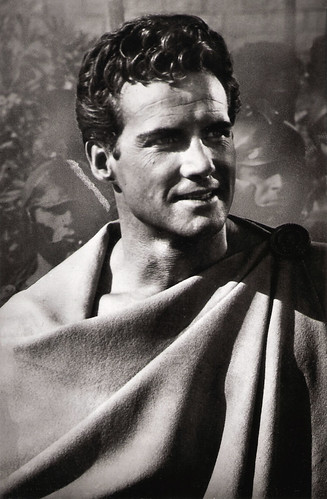
Spanish postcard by Edicion "Archivo Bermejo", no. 7006. Photo: Floralva. Steve Reeves in La battaglia di Maratona/The Giant of Marathon (Jacques Tourneur, Bruno Vailati, 1959).

Spanish postcard by Edicion "Archivo Bermejo", no. 7021. Photo: Floralva. Steve Reeves in La battaglia di Maratona/The Giant of Marathon (Jacques Tourneur, Bruno Vailati, 1959).
Mr. Universe
Stephen L. Reeves was born on a cattle ranch in the small town of Glasgow, Montana, in 1926. At the age of six months, he won his first fitness title as Healthiest Baby of Valley County. When Steve was 10, his father, Lester Dell Reeves, died in a farming accident. With his mother Goldie Reeves, Steve moved to California.
In high school in Oakland, Reeves began to work out regularly with weights, and he eventually came to the attention of Ed Yarick, who ran a bodybuilding gym. After graduating from high school, he enlisted in the Army and served in the Philippines during World War II and in Japan afterwards.
After his military service, at the age of 20, he won the title Mr. Pacific Coast (1946) in Oregon, which led to his titles of Mr. Western America (1947), Mr. America (1947), Mr. World (1948) and, ultimately, Mr. Universe (1950). The very night after he won the Mr. Universe title, he announced his retirement from bodybuilding competition at the age of 25.
With all the body-worshipping publicity he garnered, Reeves had become interested in pursuing an acting career. He moved to New York and studied acting under Stella Adler but after arguments, he was refunded his tuition. He was selected by Cecil B. DeMille for the lead role of Samson in the biblical costumer Samson and Delilah (1949) after Burt Lancaster proved unavailable. In order to look convincing on-camera, he was told to lose 15 pounds as the camera added weight. He would not be able to compete in bodybuilding with the diminished weight, so he turned the film offer down. The part instead went to Victor Mature.
In 1949 Steve did film a Tarzan-type television pilot called Kimbar of the Jungle (Robert Emmett Tansey, 1949). He was one of the Olympic Team members not interested in the charms of Jane Russell in Gentlemen Prefer Blondes (Howard Hawks, 1953). In 1954 he had a small role in the musical Athena (Richard Thorpe, 1954) playing Jane Powell's boyfriend. The same year Reeves had a small role as a detective in Ed Wood’s attempt to make a serious Film Noir, Jail Bait (Edward D. Wood Jr., 1954). On TV, Reeves guest starred on The Ray Bolger Show (1954) and The George Burns and Gracie Allen Show (1957). These roles were mostly posing bits or walk-ons. To Hollywood, Reeves was just a body. But then his fortunes turned.
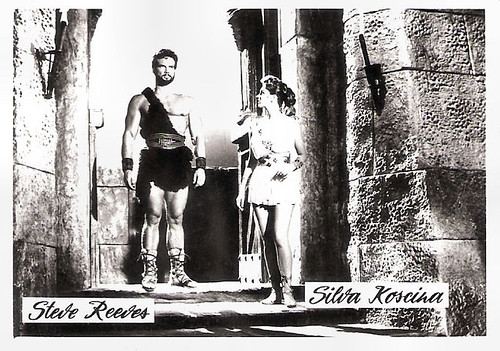
Small Romanian collectors card. Photo: publicity still for Ercole e la regina di Lidia/Hercules Unchained (Pietro Francisci, 1959) with Sylva Koscina.
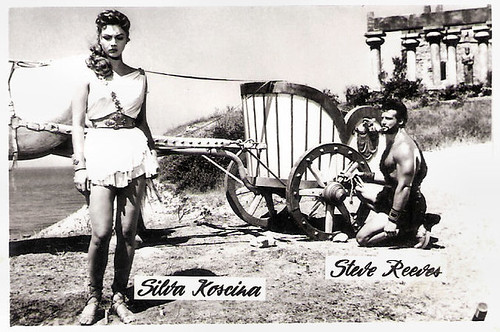
Small Romanian collectors card. Photo: publicity still for Ercole e la regina di Lidia/Hercules Unchained (Pietro Francisci, 1959) with Sylva Koscina.
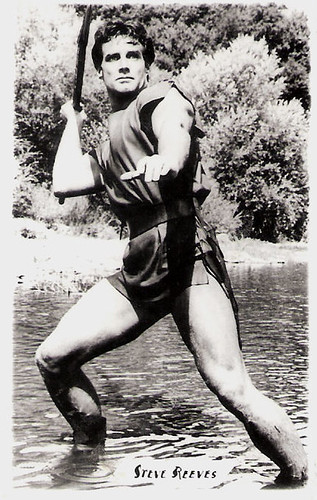
Small Romanian collectors card.
Herculean acting talent by any stretch
Italian film director Pietro Francisci’s daughter saw Steve Reeves in Athena (Richard Thorpe, 1954) and she recommended him to her father. Francisci invited Reeves to come to Cinecitta, the Roman film studios. In 1957, Reeves played the lead character in Le fatiche di Ercole/Hercules (Pietro Francisci, 1958), opposite gorgeous Sylva Koscina.
Hercules was a relatively low-budget epic based loosely on the tales of Jason and the Argonauts, though inserting Hercules into the lead role. Gary Brumburgh at IMDb: “Though he did not possess a Herculean acting talent by any stretch, handsome bodybuilder Steve Reeves certainly had an enviable Herculean physique, and made plenty good use of it in Europe.”
Independent film producer Joseph E. Levine took a big chance and bought the rights to the film's American release. He added a soundtrack dubbed in English and after a major US advertising campaign on television and in the newspapers, Hercules became one of the surprise hits of 1959.
Reeves became ‘overnight’ a star. The film’s international success quickly led to the sequel Ercole e la regina di Lidia/Hercules Unchained (Pietro Francisci, 1959), again with Sylva Koscina. Hercules Unchained made even more money and became one of the year's biggest grossing films.
Although he is now best known for his portrayal of Hercules, Reeves played the character only twice. Next he played 19th century Tatar hero Hadji Murad in Agi Murad il diavolo bianco/White Warrior (Riccardo Freda, 1959) with Giorgia Moll. This was followed by his role as Goliath (in Italy Emiliano) in Il terrore dei barbari/Goliath and the Barbarians (Carlo Campogalliani, 1959) with Chelo Alonso. While filming Gli ultimi giorni di Pompei/The Last Days of Pompeii (Mario Bonnard, Sergio Leone (uncredited), 1959), the chariot Reeves was driving struck a tree and he dislocated his shoulder. This put an end to his more intense exercise routines and caused problems in the following years.

German postcard, no. 708. Steve Reeves' surname is misspelled as Reves.
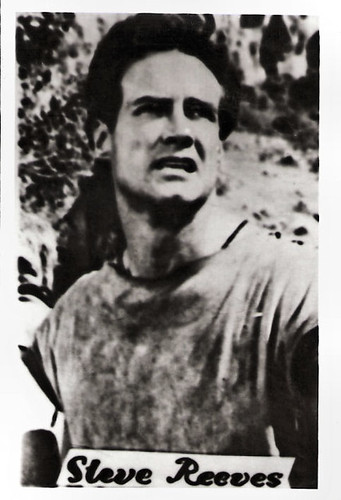
Small Romanian collectors card.
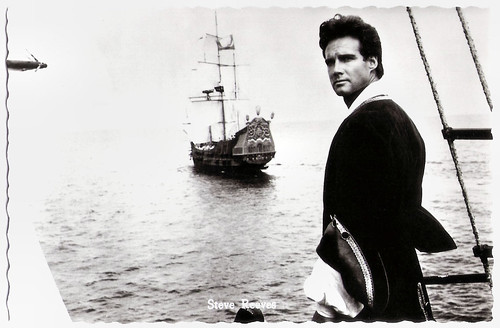
Dutch postcard by N.V. v.h. Weenenk & Snel, Baarn, no. 661. Photo: MGM. Publicity still for Morgan il pirata/Morgan the Pirate (André De Toth, Primo Zeglio, 1960).
Number-one, box-office draw in twenty-five countries
By 1960, Steve Reeves was ranked as the number-one, box-office draw in twenty-five countries around the world. From then on through 1964, Reeves went on to appear in a string of Peplum (sword & sandal films) shot on relatively small budgets.
He played a number of characters on-screen, including Welsh pirate and self-proclaimed governor of Jamaica, Captain Henry Morgan in Morgan il pirata/Morgan the Pirate (André De Toth, Primo Zeglio, 1960), Karim, the fabled Thief of Baghdad in Il ladro di Bagdad/The Thief of Baghdad (Arthur Lubin, Bruno Vailati, 1961), and Randus, the son of Spartacus in Il figlio di Spartacus/The Slave: The Son of Spartacus (Sergio Corbucci, 1962).
He also played Romulus, the legendary founder of Rome in Romolo e Remo/Duel of the Titans (Sergio Corbucci, 1961) opposite Gordon Scott as his twin brother Remus. Reeves reportedly turned down two roles that became international sensations. Cubby Broccoli offered him the role of James Bond in Dr. No (Terence Young, 1962), but Reeves refused it because of the low salary the producer offered. Reeves also turned down the role of ‘The Man with No name’ that finally went to Clint Eastwood in A Fistful of Dollars (Sergio Leone, 1964) because he could not believe that "Italians could make a Western".
He played Aeneas of Troy in La leggenda di Enea/The Avenger (Giorgio Venturini, 1962) and twice, he played Emilio Salgari's Malaysian hero, Sandokan in Sandokan, la tigre di Mompracem/Sandokan the Great (Umberto Lenzi, 1963) with Geneviève Grad, and in I pirati della Malesia/The Pirates of Malaysia (Umberto Lenzi, 1964) with Jacqueline Sassard as the romantic interest.
Reeves’ injury of The Last Days of Pompeii, was aggravated by his stunt work in each successive film, ultimately leading to his retirement from filmmaking. In 1968 he appeared in his final film, Vivo per la tua morte/I Live For Your Death!/A Long Ride From Hell (Camillo Bazzoni, 1968), a Spaghetti Western he co-wrote.
His first wife had been Sandra Smith (1955-1956). In 1963, he married Aline Czarzawicz and the couple moved in 1969 to Valley Center, California, northeast of San Diego. He had bought a ranch there with the savings from his film career. For the next two decades, Reeves bred horses and promoted drug-free bodybuilding. He stayed with Aline, until her death in 1989.
In 1994, Reeves and business partner George Helmer started the Steve Reeves International Society, which became through its Internet site, a leading proponent of drug-free bodybuilding. In 1996, it incorporated to become Steve Reeves International Inc. Reeves also wrote the book Powerwalking, and two self-published books, Building the Classic Physique - The Natural Way, and Dynamic Muscle Building.
His last screen appearance was in 2000 when he appeared as himself in the made-for-television A&E Biography: Arnold Schwarzenegger — Flex Appeal. In 2000, Reeves died in a hospital in Escondido, California, from a blood clot after having surgery two days earlier. He passed away on the very day that Ridley Scott's Gladiator (2000) premiered, the first Sword and Sandal epic to be produced by Hollywood in many years. Steve Reeves was 74.
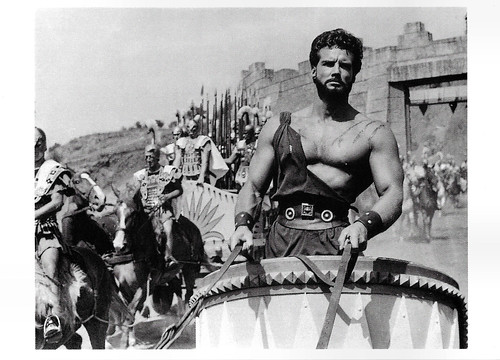
Swiss-German-British postcard by News Productions, Baulmes / Filmwelt Berlin, Bakede / News Productions, Stroud, no. 56496 Photo: Collection Cinémathèque Suisse, Lausanne. Steve Reeves in Ercole e la Regina di Lidia/Hercules Unchained (Pietro Francisci, 1958), produced by Lux-Galatea / Lux France.

Belgian photo by Elan Film. Steve Reeves in La battaglia di Maratona/The Giant of Marathon (Jacques Tourneur, Bruno Vailati, 1959).

Belgian collectors card. Photo: Apollon Films.
Scene from The George Burns and Gracie Allen Show (1957). Source: Marek546 (YouTube).
Sources: Gary Brumburgh (IMDb), Rick Lyman (The New York Times), Wikipedia and IMDb.
1 comment:
Great documentary
Post a Comment